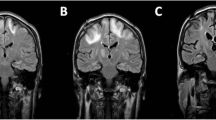Summary
A 57-year-old male was repeatedly admitted to hospital because of complex neurological symptoms, including radicular pain, disturbance of micturition, seizures, and severely impaired mental state. The diagnosis was encephalomyeloradiculitis possibly of viral origin, and treatment with immunosuppressants was initiated. An alternating course with a tendency towards improvement ensued. Two and a half years after the occurrence of the initial symptoms, identification of specific antibodies in the blood and CSF led to the diagnosis of borreliosis with CNS involvement. High-dose therapy with penicillin rapidly reduced the symptoms, beginning with those of radicular pain and followed by an improvement of the mental state. Attention is directed to the wide spectrum of clinical symptoms of chronic borreliosis with CNS involvement. Previous reports that immunosuppression may result in some improvement but with a tendency towards relapse are confirmed. Our encouraging treatment results support those of other reports that penicillin therapy may lead to improvement even at late chronic stages in patients with severe CNS deficits.
Similar content being viewed by others
References
Ackermann R (1983) Erythema chronicum migrans und durch Zecken übertragene Meningopolyneuritis (Garin-Bujadoux-Bannwarth): Borrelien-Infektionen? Dtsch Med Wochenschr 108:577
Ackermann R (1986) Erythema-migrans-Borreliose und Frühsommer-Meningoencephalitis. Dtsch Ärztebl 83:1765–1774
Ackermann R, Kabatzki J, Doisten HP, Runnei U, Steere AC, Grodzicki RL, Hartung S (1984) Spirochäten-Ätiologie der Erythema chronicum-migrans-Krankheit. Dtsch Med Wochenschr 109:92
Ackermann R, Gollmer E, Rhese-Küpper B (1985) Progressive Borrelien-Encephalomyelitis. Dtsch Med Wochenschr 110:1039–1042
Benach JL, Bosler EM, Hanrahn JP, Choleman JL, Habicht GS, Bast TF, Cameron DJ, Ziegler JL, Barbour AG, Burgdorfer W, Edelman R, Kaslow RA (1983) Spirochetes isolated from the blood of two patients with Lyme disease. N Engl J Med 308:740
Burgdorfer W, Barbour AG, Hayes SF, Benach JL, Grundwaldt JP, Davis JP (1982) Lyme disease — a tick-borne-spirochetosis? Science 216:1317
Burgdorfer W, Barbour AG, Hayes SF, Peter O, Aeschlimann A (1983) Erythema chronicum migrans — a tick-borne spirochetosis. Acta Trop (Basel) 40:79–83
Christen H-J, Delekat D, Rating D, Hanefeld F (1985) Erythema migrans-Krankheit — Drei Fallbeispiele mit neurologischen Komplikationen. Monatsschr Kinderheilkd 133:732–737
Garin C, Bujadoux C (1922) Paralysis par les tiques. J Med Lyon 71:765–767
Klenk W, Heitmann R, Ackermann R (1985) Rezidivierende Erythema-chronicum-migrans-Krankheit des Nervensystems: Garin-Bujadoux-Bannwarth, Kasuistik. Aktuel Neurol 12:20–23
Kohler J, Kaper J, Kern U, Thoden U, Rhese-Küpper B (1986) Borrelia encephalomyelitis. Lancet II:35
Pachner AMD, Steere AC (1985) The triad of neurologic manifestations of Lyme disease: meningitis, cranial neuritis, and radiculoneuritis. Neurology 35:47–53
Preac-Mursic V, Schierz G, Pfister HW, Einhäupl K, Wilske B, Weber K (1984) Isolierung einer Spirochäte aus Liquor cerebrospinalis bei Meningoradikulitis Bannwarth. Münch Med Wochenschr 126:275
Raucher HS, Kaufman DM, Goldfarb J, Jacobson RI, Roseman B, Wolff RR (1985) Pseudotumor cerebri and Lyme disease: a new association. J Pediatr 107:931–933
Reik L, Smith L, Khan A, Nelson W (1985) Demyelinating encephalopathy in Lyme disease. Neurology 35:267–269
Reik L, Burgdorfer W, Donaldson JO (1986) Neurologic abnormalities in Lyme disease without erythema chronicum migrans. Am J Med 81:73–78
Ryberg B, Nilsson B, Burgdorfer W, Barbour AG (1983) Antibodies to Lyme disease — spirochete in European lymphocytic meningo-radiculitis (Bannwarth's syndrome). Lancet II:519
Satz N, Ott A, Zogg F, Knoblauch M (1986) Die Erythema-migrans-Krankheit. Schweiz Med Wochenschr 116:763–769
Steere AC, Grodzicki RL, Kornblatt AN, Craft JE, Barbour AG, Burgdorfer W, Schmid GP, Johnson E, Malawista SE (1983) The spirochetal etiology of Lyme disease. N Engl J Med 308:733
Weder B, Wiedersheim P, Matter L, Steck A, Otto F (1987) Chronic progressive neurological involvement in Borrelia burgdorferi infection. J Neurol 234:40–43
Wörth WD (1985) Diagnostik der Erythema migrans-Krankheit (Lyme-Krankheit). Dtsch Med Wochenschr 110:1377–1379
Wörth WD (1985) Therapie der Erythema migrans-Krankheit (Lyme-Krankheit). Dtsch Med Wochenschr 110:1379–1380
Author information
Authors and Affiliations
Rights and permissions
About this article
Cite this article
Kollikowski, H.H., Schwendemann, G., Schulz, M. et al. Chronic borrelia encephalomyeloradiculitis with severe mental disturbance: immunosuppressive versus antibiotic therapy. J Neurol 235, 140–142 (1988). https://doi.org/10.1007/BF00314303
Received:
Revised:
Accepted:
Issue Date:
DOI: https://doi.org/10.1007/BF00314303




